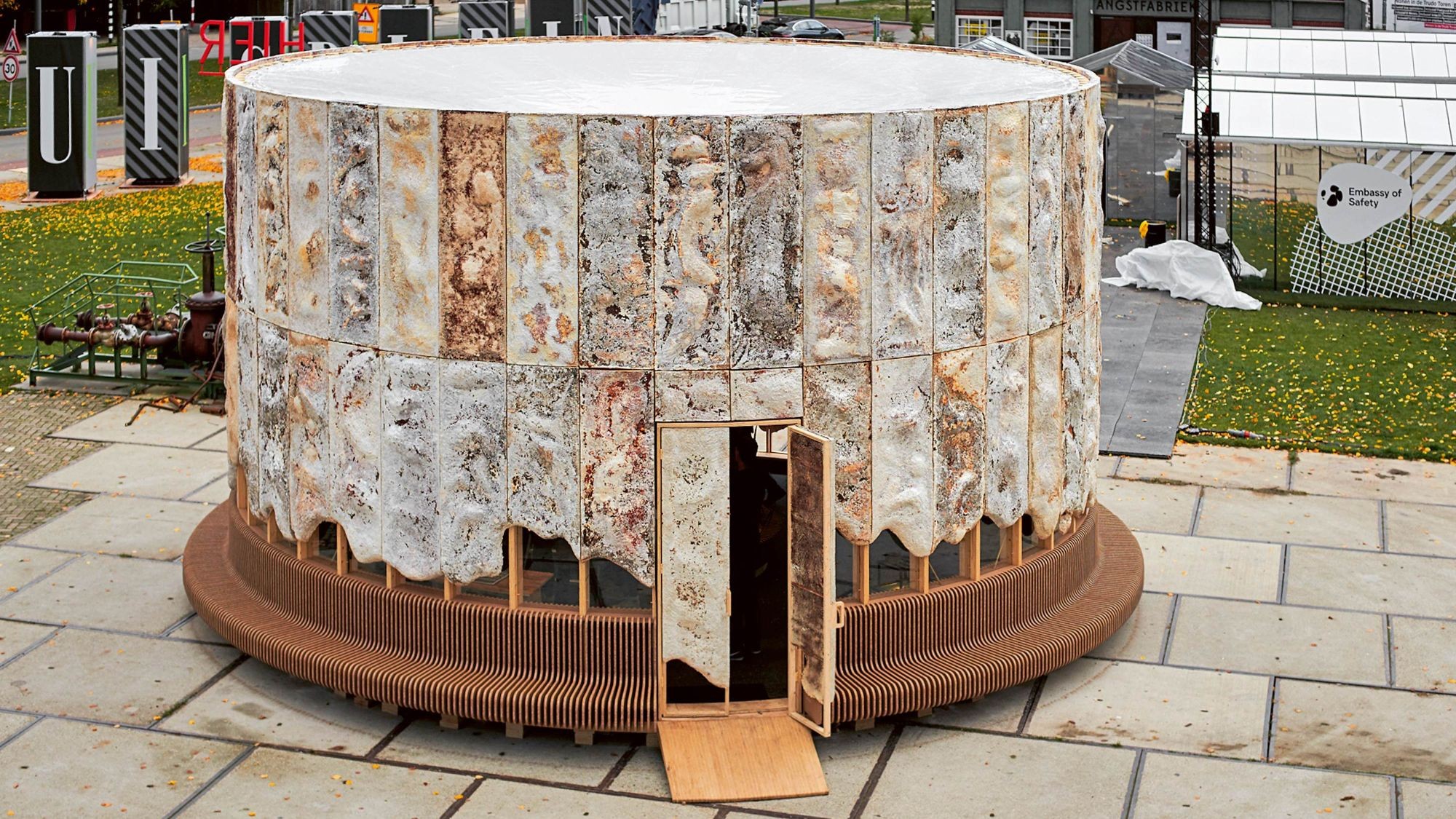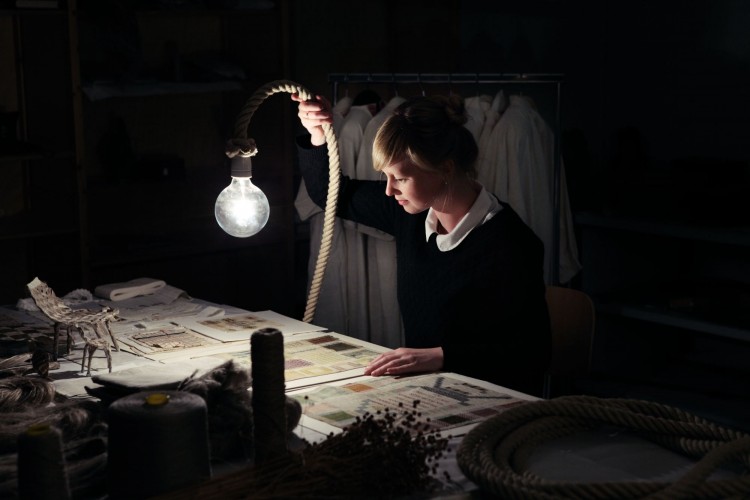Μύκητες και μανιτάρια στο βιώσιμο design
DS.WRITER:
Ιωακειμίδου Χριστίνα
Κεντρική Εικόνα: The Growing Pavilion (Lucas De Man & Pascal Leboucq) | Πηγή εικόνας: arquitecturaviva.com
Στην εποχή τής όλο και αυξανόμενης βιομηχανικής επεξεργασίας των διαφόρων πρώτων υλών, υπάρχουν πρωτοβουλίες από ομάδες που στρέφονται προς την κατεργασία των φυσικών υλικών, με σκοπό τη χρήση τους στους τομείς του design και του αρχιτεκτονικού σχεδιασμού. Αν και αυτές οι πρακτικές ακολουθούνταν από την αρχαιότητα, τον 21ο αιώνα έχουν επαναπροσδιορίσει τον τρόπο με τον οποίο μπορούμε να προσεγγίσουμε το εκάστοτε υλικό, ούτως ώστε να επιτευχθεί η δημιουργία ενός άρτιου τελικού αποτελέσματος, σεβόμενοι πάντα το περιβάλλον.
Φελιζόλ από μύκητες
Εδώ και αρκετές δεκαετίες, διεθνείς οργανισμοί κρούουν τον κώδωνα του κινδύνου για τις επιπτώσεις της κλιματικής αλλαγής και τους τρόπους σταδιακού περιορισμού τής υπερθέρμανσης του πλανήτη, χωρίς, ωστόσο, να υπάρχει κάποια γενικευμένη και ουσιαστική θεσμική κίνηση. Σύμφωνα με έκθεση της Διακυβερνητικής Επιτροπής των Ηνωμένων Εθνών για την Κλιματική Αλλαγή (IPCC), μόνο το 2018 είχε απελευθερωθεί στην ατμόσφαιρα ένα πολύ μεγάλο ποσοστό επιβλαβών εκπομπών διοξειδίου του άνθρακα, που αγγίζει το 89%, και το οποίο προέρχεται από την καύση ορυκτών καυσίμων, τον νούμερο ένα παράγοντα πρόκλησης περιβαλλοντικής μόλυνσης. Φυσικά, μεγάλη ευθύνη για την όλο και αυξανόμενη απελευθέρωση επικίνδυνων αερίων και αποβλήτων έχει και ο κατασκευαστικός τομέας, αφού η χρήση υλικών όπως το σκυρόδεμα και το φελιζόλ μπορεί μακροπρόθεσμα να αποβεί μοιραία για το περιβάλλον. Δεν πρέπει, άλλωστε, να ξεχνάμε, ότι το φελιζόλ -ως πλαστικό υλικό- έχει διάρκεια ζωής έως και 500 χρόνια, με ό,τι αυτό συνεπάγεται για την καταστροφή που μπορεί να επιφέρει στο περιβάλλον η απομάκρυνσή του στους χώρους υγειονομικών ταφών.
Τα προβλήματα αυτά και οι επιπτώσεις των βιομηχανικών προϊόντων στο περιβάλλον, έχουν οδηγήσει στη στροφή κάποιων σχεδιαστών στην επεξεργασία προϊόντων βιολογικής βάσης και ανανεώσιμων πηγών, όπως είναι το ξύλο, το σκυρόδεμα από κάνναβη, το ανακυκλωμένο χαρτί, μέχρι και τα τσόφλια αυγών. Παράλληλα, η αντικατάσταση των υλικών που προέρχονται από δέρμα, πολλές φορές, γίνεται μέσω της κατεργασίας υπολειμμάτων φρούτων, ενώ σε πολλές περιπτώσεις υπάρχει και η χρήση της τρισδιάστατης εκτύπωσης αντικειμένων που προέρχονται από απορρίμματα και μύκητες, όπως για παράδειγμα το μυκήλιο, το οποίο χρησιμοποιείται συχνά ως μονωτικό υλικό. Για να είμαστε πιο επεξηγηματικοί αναφορικά με τη συγκεκριμένη πρώτη ύλη, το μυκήλιο είναι το φυτικό μέρος ενός μύκητα. Αναπτύσσεται σχηματίζοντας μία νηματώδη διακλαδωτή μάζα στο έδαφος και σε άλλα υποστρώματα. Αυτό το υπόγειο, νηματοειδές δίκτυο των μυκήτων, το οποίο συχνά αναφέρεται ως Wood Wide Web, είναι ζωτικής σημασίας για την επιβίωση του φυσικού μας περιβάλλοντος, καθώς σχηματίζει δεσμούς με τα ριζικά δίκτυα των φυτών και των δέντρων, αναπτύσσοντας με αυτό τον τρόπο ένα υπόγειο δίκτυο, ικανό να μεταφέρει θρεπτικά συστατικά και να προστατεύσει παράλληλα το φυτό από επικίνδυνες ουσίες. Επιπλέον, αυτό είναι υπεύθυνο για τη διάσπαση των νεκρών φυτών και οργανισμών, την αναζωογόνηση του εδάφους και τη δυνατότητα ανάπτυξης της ζωής των νέων φυτικών οργανισμών.
Έτσι, με την κατάλληλη χρήση της τεχνολογίας, τα παραπάνω προϊόντα μπορούν να μεταμορφωθούν σε οικοδομικά υλικά, όπως μας αποδεικνύουν με τη δουλειά τους οι Lucas De Man και Pascal Leboucq (Biobased Creations). Βασίζοντας τη δουλειά τους στην κυκλική βιοοικονομία, οι De Man και Leboucq προχώρησαν στη δημιουργία του The Growing Pavilion, που πρωτοπαρουσιάστηκε στην Dutch Design Week του 2019 και ξαναδημιουργήθηκε για τη Floriade Expo του 2022. Το περίπτερο της ολλανδικής έκθεσης είναι κατασκευασμένο από φυσικά υλικά, όπως ξύλο και βαμβάκι, ενώ γενικότερα έχουν χρησιμοποιηθεί και υπολείμματα του αγροτικού τομέα και τύφα. Η χρήση του μυκηλίου εφαρμόζεται αντί φελιζόλ, επιτυγχάνοντας με αυτό τον τρόπο την ολική αποφυγή της ένταξης, στην όλη κατασκευή, ορυκτών πόρων ή πλαστικού. Όπως δηλώνουν οι designers, η κατασκευή είναι αφιερωμένη στα βιοβασικά υλικά, που προσδίδουν μία διαφορετική αισθητική στο τελικό αποτέλεσμα. Παράλληλα, η άψογη συνεργασία των πρώτων υλών αποδεικνύεται, αφού όλα τα διαφορετικά προϊόντα που χρησιμοποιήθηκαν είναι ευδιάκριτα.
 Oscar Vinck_0.jpg)
The Growing Pavilion (Dutch design week, 2019) | Πηγή εικόνας: 2021.prizes.new-european-bauhaus.eu
Παρόμοια οπτική ως προς τη χρήση των υλικών έχει και η ομάδα του Blast Studio. Εκμεταλλευόμενοι τις ιδιότητες του μυκηλίου, οι Paola Garnousset, Martin Detoeuf και Pierre de Pingon δημιουργούν με τη βοήθεια, κυρίως, της τρισδιάστατης εκτύπωσης έπιπλα, γλυπτά και γενικότερα αντικείμενα εσωτερικού χώρου, κατασκευασμένα από ένα κράμα φλιτζανιών καφέ -προερχόμενων από τα απορρίμματα- και μυκηλίου. Παράδειγμα του τρόπου σχεδιασμού τους αποτελεί το Tree Column, δημιουργημένο μέσω ενός αλγορίθμου που είναι ικανός να παράγει σχήματα που ευνοούν την ανάπτυξη και επεξεργασία του μυκηλίου. Με τη σειρά της, η οριζόντια τομή του Tree Column μπόρεσε να οδηγήσει, σχεδιαστικά, στο τραπεζάκι για καφέ Tree Table, αποδεικνύοντας ότι η χρηστικότητα των αντικειμένων δεν προκαθορίζεται από το υλικό κατασκευής τους.
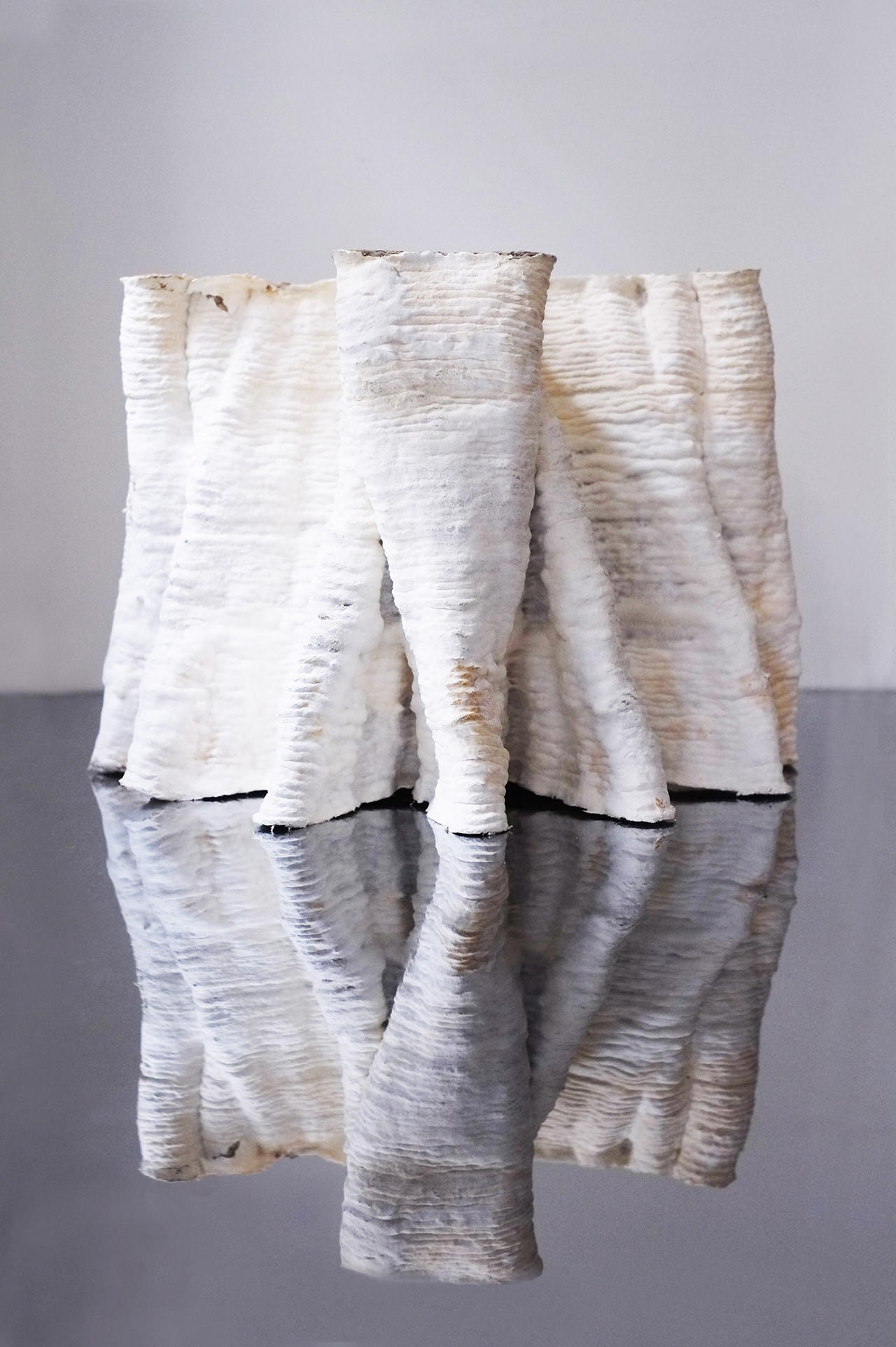
Πηγή εικόνας: design-milk.com
Design από μανιτάρια
Η συμβολή των μυκήτων και των βακτηρίων στην προστασία και την υγιή ανάπτυξη του περιβάλλοντος είναι αποδεδειγμένη, παρόλο που οι δύο λέξεις έχουν αποκτήσει μία διαφορετική -ίσως τρομακτική- χροιά στον καθημερινό λόγο. Σκεπτόμενος την ιδιότητα αυτή των μυκήτων, ο product και furniture designer Satoshi Itasaka προχώρησε στην κατασκευή της Fungi Stool. Το κάθισμα, που αποτελείται από έναν ξύλινο και μεταλλικό σκελετό, είναι στην κυριολεξία ένας ζωντανός οργανισμός, αφού οι φυτικοί μύκητες με την πάροδο του χρόνου μεγαλώνουν σε μανιτάρια. Με τον τρόπο αυτόν το κάθισμα ανθίζει, παίρνοντας τη μορφή ενός μεγάλου όγκου μανιταριών μέσα στον χώρο. Παρόμοια είναι και η δουλειά στο Burlasite, το μεγάλο installation του διδύμου, που μπόρεσε να κερδίσει φέτος στην αρχιτεκτονική Μπιενάλε του Τατλίν, και το οποίο είναι βασισμένο στη 3D εκτύπωση και τη χρήση του μυκηλίου. Για άλλη μία φορά, χρησιμοποιείται το ξύλο -προερχόμενο από απόβλητα της τοπικής ξυλείας- για τον 3D εκτυπωμένο σκελετό της κατασκευής, η οποία κάνει εμφανή την πάροδο του χρόνου μέσα από τις διαδικασίες σύνθεσης και αποσύνθεσης των υλικών, αφού, μέσω της έγχυσης των μανιταριών στα θεμέλιά του, το μυκήλιο θα αναπτυχθεί και θα σκληρύνει, με σκοπό τη δημιουργία ενός συμπαγούς θεμελίου και εξωτερικής επένδυσης.
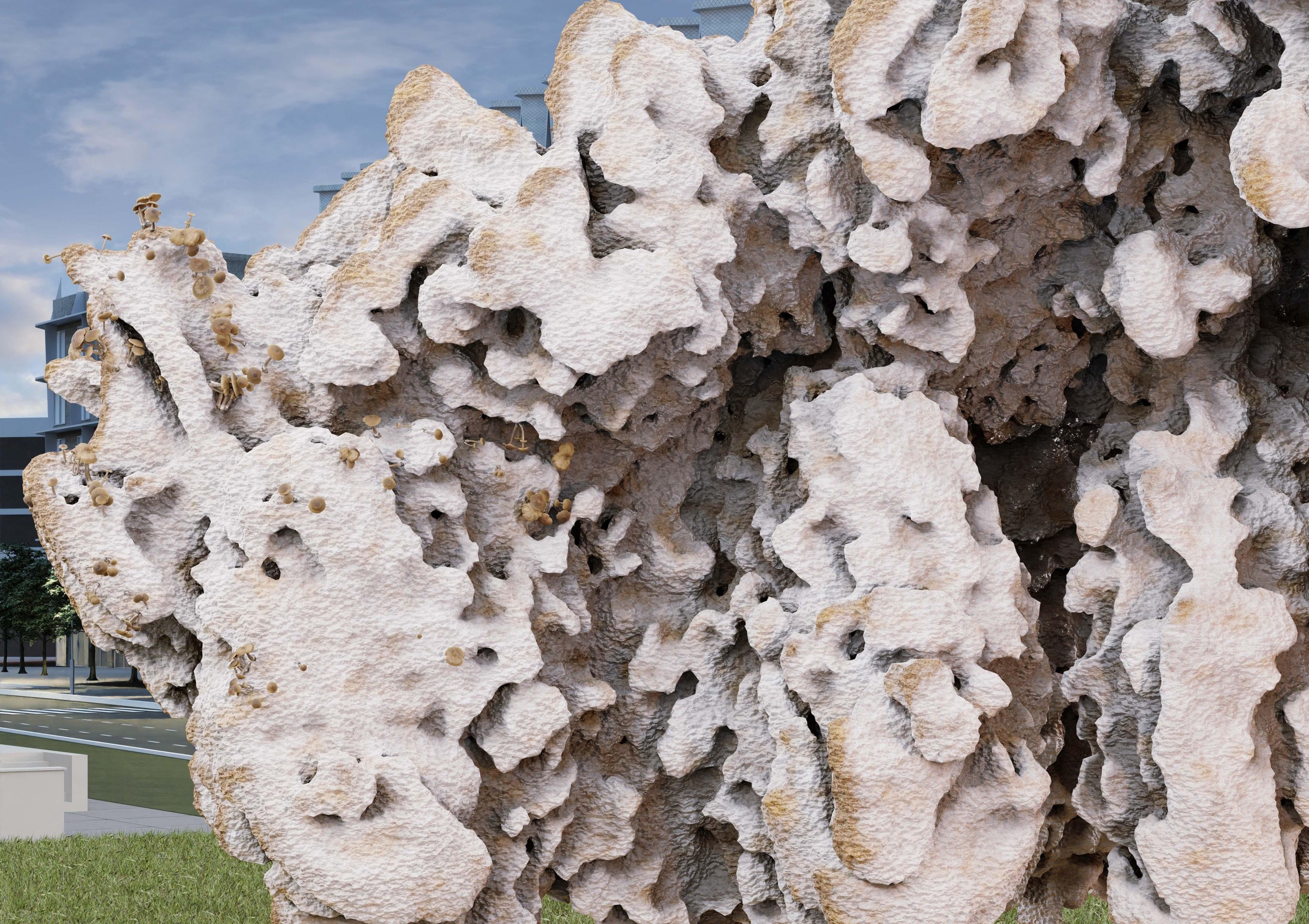
Όψη του μυκηλίου εξωτερικά του Burlasite. Πηγή εικόνας: freight.cargo.site
Οι ιδιότητες του μυκηλίου, φυσικά, έχουν αναγνωριστεί και από άλλους designers. Ανάμεσά τους οι Sebastian Cox and Ninela Ivanova, Phil Ross (MycoWorks) και Ehab Sayed (Biohm). Εκμεταλλευόμενοι το μυκήλιο προχώρησαν στην κατασκευή αντικειμένων που μπορούν να είναι φιλικά προς το περιβάλλον, χωρίς, ωστόσο, να χάσουν τίποτα από τον στόχο για άνεση και design.
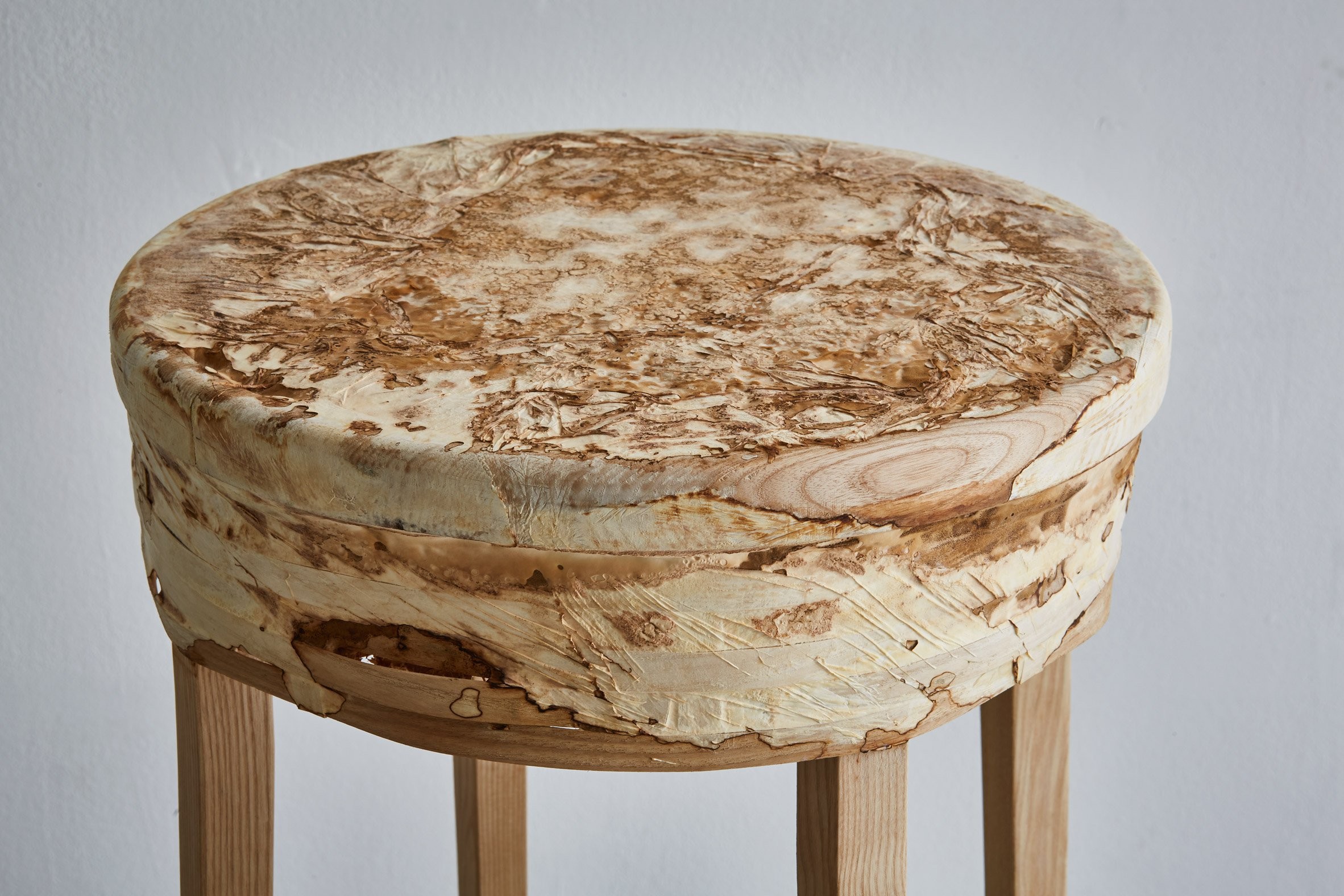
Κάθισμα από ξύλο και μυκήλιο (Sebastian Cox & Ninela Ivanova) | Πηγή εικόνας: criticalconcrete.com
Προορίζονται όλα τα υλικά για όλους τους τομείς;
Ωστόσο, δεν θα πρέπει να μας διαφεύγει το γεγονός, ότι ο σκοπός της στροφής προς τα βιοδιασπώμενα και εναλλακτικά υλικά είναι να εντοπιστούν τα βασικά τους προτερήματα και να χρησιμοποιηθούν με τρόπο, που, εκτός των άλλων, ωφελεί το περιβάλλον και ενεργειακά. Προφανώς, οι άκρως ελπιδοφόρες αυτές προσπάθειες βρίσκονται σε πειραματικό στάδιο, αλλά δεν θα πρέπει να ξεχνάμε, πως η καθολική χρήση των ποικίλων εναλλακτικών υλικών μπορεί να φέρει τα αντίστροφα από τα επιθυμητά αποτελέσματα. Για τον λόγο αυτόν, τα μικρά και προσεκτικά βήματα είναι απαραίτητα για τον δρόμο προς τη βιωσιμότητα και την αποφυγή καταστροφικών λαθών στο μέλλον.
Πηγές / Περαιτέρω ανάγνωση
Έκθεση του ΟΗΕ για το Kλίμα – Αντόνιο Γκουτέρες: Βρισκόμαστε σε ταχεία πορεία προς την καταστροφή. Από: unric.org.
The Intergovernmental Panel on Climate Change. Από: ipcc.ch.
Internal Market, Industry, Entrepreneurship and SMEs. Από: single-market-economy.ec.europa.eu.
S. Menjivar & F. Gorji (2021). What are Bio-based materials? Από: plugandplaytechcenter.com.
Fungi grow and bloom like flowers in satoshi itasaka's mushroom stool. Από: designboom.com.
K. Cowan (2019). Ehab Sayed of Biohm on sustainable materials, growing mushrooms that eat plastic and changing the industry. Από: materialsource.co.uk.
BUILDING WITH MUSHROOMS. Από: criticalconcrete.com.
*Για τους Biobased Creations, στο: biobasedcreations.com.
*Για τους Blast studio, στο: blast-studio.com.
*Για το MycoWorks, στο: mycoworks.com.
*Για τους Sebastian Cox and Ninela Ivanova, στο: sebastiancox.co.uk.




